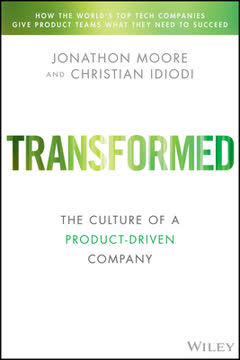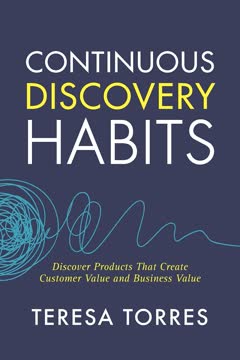Key Takeaways
1. Empathy is the cornerstone of effective product leadership
Empathy is possibly the most important leadership quality: It not only allows you to influence others and encourage change but also creates trust and psychological safety—an environment in which people feel safe to speak up and are comfortable to be themselves.
Cultivate genuine care. Empathy enables product leaders to understand user needs, connect with team members, and align stakeholders. It goes beyond simply acknowledging others' perspectives; it involves actively seeking to understand their feelings, motivations, and challenges. By cultivating empathy, leaders create an environment of trust and psychological safety, encouraging open communication and innovation.
Strengthen empathy through practice. To develop empathy:
- Actively listen without judgment
- Ask open-ended questions to understand others' viewpoints
- Put yourself in others' shoes
- Practice mindfulness to increase self-awareness
- Seek diverse perspectives and experiences
Remember, empathy is not about agreeing with everyone, but about understanding and valuing different viewpoints. This understanding forms the foundation for effective decision-making, conflict resolution, and team collaboration.
2. Collaborative decision-making leads to better outcomes
Better decisions: Deciding together leverages the collective knowledge and creativity of the dev team and stakeholders. It helps you consider all viewpoints, thereby reducing the risk of wrong and biased decisions.
Embrace diverse perspectives. Collaborative decision-making harnesses the collective intelligence of the team, leading to more innovative and robust solutions. It reduces the risk of individual biases and blind spots, ensuring a more comprehensive evaluation of options. Moreover, involving team members in the decision-making process increases their commitment to the chosen course of action.
Implement effective collaboration techniques:
- Use structured brainstorming to gather diverse ideas
- Employ decision-making frameworks like consent or unanimity
- Set clear ground rules for respectful and open discussion
- Utilize tools like agreement scales to gauge consensus
- Encourage devil's advocate thinking to challenge assumptions
Remember to balance collaboration with efficiency. Not every decision requires full team involvement. Develop a framework for determining which decisions warrant collaborative input and which can be made individually or delegated.
3. Cultivate a growth mindset to continuously improve
"Leadership and learning are indispensable to each other," as John F. Kennedy once noted. In order to be an effective leader, it is important to develop relevant skills, like effectively making decisions and resolving conflict, and to grow as an individual—learn to better deal with difficult mind states and become a more empathic person.
Embrace challenges as opportunities. A growth mindset is the belief that abilities and intelligence can be developed through dedication and hard work. For product leaders, this mindset is crucial for adapting to rapidly changing markets, technologies, and user needs. It encourages continuous learning, resilience in the face of setbacks, and openness to feedback.
Foster a culture of learning and experimentation:
- Encourage calculated risk-taking and view failures as learning experiences
- Provide regular opportunities for skill development and knowledge sharing
- Celebrate effort and progress, not just outcomes
- Model vulnerability by admitting mistakes and sharing learning experiences
- Create safe spaces for team members to try new approaches and ideas
By cultivating a growth mindset in yourself and your team, you create an environment that thrives on innovation, adapts quickly to change, and continuously improves both products and processes.
4. Practice mindfulness to enhance leadership capabilities
Mindfulness helps you make better decisions for the following two reasons: First, it helps you recognise cognitive biases. These include confirmation bias, the tendency to prefer data that confirm preconceived views; negativity bias, focusing on negative experiences; and overconfidence bias, overestimating the reliability of one's own judgements, control, and chances of success.
Enhance self-awareness and decision-making. Mindfulness, the practice of paying attention to the present moment without judgment, can significantly improve a product leader's effectiveness. It enhances emotional intelligence, reduces stress, and improves focus and clarity of thought. This heightened awareness allows leaders to make more balanced decisions, respond rather than react to challenges, and maintain composure in high-pressure situations.
Incorporate mindfulness into your routine:
- Start with short, daily meditation sessions (even 1-5 minutes can be beneficial)
- Practice mindful breathing during transitions between tasks or meetings
- Conduct regular personal retrospectives to reflect on experiences and learnings
- Use mindfulness apps or guided sessions to build the habit
- Encourage team mindfulness practices, such as starting meetings with a moment of silence
By cultivating mindfulness, product leaders can improve their ability to listen deeply, communicate clearly, and make decisions with greater clarity and purpose.
5. Master the art of active listening and effective communication
Being empathic does not require you to be happy and smiley all the time, nor does it mean sugar-coating messages, only telling people what they want to hear, and ignoring issues. Instead, it means caring about the other person and wanting to help the individual as much as is possible.
Listen to understand, not to respond. Active listening is a crucial skill for product leaders. It involves fully concentrating on what is being said, understanding the message, and responding thoughtfully. By mastering this skill, leaders can build stronger relationships, gather more accurate information, and make better-informed decisions.
Improve your communication skills:
- Practice empathetic listening: focus on understanding the speaker's perspective and emotions
- Use open-ended questions to encourage deeper discussion
- Paraphrase and summarize to ensure understanding
- Pay attention to non-verbal cues
- Provide constructive feedback that is specific, timely, and actionable
- Tailor your communication style to your audience
Remember, effective communication is a two-way street. Create an environment where team members feel safe to express their ideas and concerns openly. This fosters innovation, problem-solving, and a more engaged team.
6. Develop a chain of goals to align stakeholders and guide development
The goals in figure 3 are linked. They form a chain with progressively refined goals: The product vision helps you discover the right user and business goals, the user and business goals help you determine the right product goals, and the product goals should help you identify the right sprint goals.
Create alignment through linked objectives. A well-structured chain of goals provides clarity and direction for the entire product team and stakeholders. It ensures that day-to-day activities are aligned with overarching product and business objectives. This alignment reduces confusion, increases efficiency, and helps maintain focus on what truly matters.
Implement a goal hierarchy:
- Product Vision: The ultimate reason for creating the product
- User and Business Goals: Strategic objectives derived from the vision
- Product Goals: Specific benefits to achieve user and business goals
- Sprint Goals: Short-term objectives that contribute to product goals
Regularly review and update these goals to ensure they remain relevant and aligned. Involve stakeholders in goal-setting to increase buy-in and commitment. Use these goals as a decision-making framework to evaluate new ideas and prioritize work.
7. Learn to constructively resolve conflicts
Conflict can be a blessing or a curse depending on how we deal with it. If we learn to skilfully navigate it, disagreement will become a source of learning and creativity.
View conflict as an opportunity. Constructive conflict resolution is essential for maintaining team harmony and driving innovation. When handled well, conflicts can lead to better solutions, stronger relationships, and improved team dynamics. The key is to approach disagreements with a mindset of collaboration rather than competition.
Apply non-violent communication techniques:
- Observations: Share facts without judgment
- Feelings: Express emotions without blaming others
- Needs: Articulate underlying needs or values
- Requests: Make clear, positive, and specific requests
Additional conflict resolution strategies:
- Focus on interests, not positions
- Separate the person from the problem
- Generate multiple options before deciding on a solution
- Use objective criteria to evaluate options
- Practice active listening and empathy
By mastering conflict resolution skills, product leaders can turn potential roadblocks into stepping stones for growth and innovation.
8. Balance different leadership styles based on the situation
To be an effective leader, attend to the needs of the development team and stakeholders and take into account group cohesion and expertise.
Adapt your approach. Effective product leadership requires flexibility in leadership style. Different situations and team dynamics call for varied approaches. By adapting your leadership style, you can maximize team performance, engagement, and satisfaction.
Consider these leadership styles:
- Visionary: Align people through shared goals
- Democratic: Involve team in decision-making
- Coaching: Develop people's long-term strengths
- Affiliative: Build relationships and harmony
- Pacesetting: Lead by example and set high standards
- Commanding: Give clear directions in crises
Factors to consider when choosing a leadership style:
- Team maturity and expertise
- Urgency of the situation
- Complexity of the task
- Team dynamics and cohesion
- Organizational culture
Remember, the most effective leaders can seamlessly switch between styles as needed, always keeping the team's and product's best interests in mind.
9. Build trust through consistent and authentic interactions
Trust is the magic ingredient that allows relationships to blossom. To trust someone means to have faith in the person, to believe that her or his intentions are good and that acting on the individual's advice will be beneficial.
Prioritize trust-building. Trust is the foundation of effective leadership and team collaboration. It enables open communication, encourages risk-taking, and fosters a sense of psychological safety. Building trust requires consistent effort and authenticity in all interactions.
Strategies to build and maintain trust:
- Be transparent in decision-making and communication
- Follow through on commitments
- Admit mistakes and show vulnerability
- Give credit where it's due
- Show genuine interest in team members' well-being and growth
- Provide constructive feedback and recognition regularly
- Create opportunities for team bonding and shared experiences
Remember that trust is easier to lose than to gain. Consistently demonstrating trustworthy behavior and fostering a culture of trust within your team will lead to stronger relationships, better collaboration, and ultimately, more successful products.
10. Empower your team by delegating decisions and fostering autonomy
An agile development team should be self-organising: The members have a joint responsibility for determining how much work can be done in a given period of time, identifying the specific tasks that have to be carried out, deciding who does what and how people collaborate, designing and implementing the product, and tracking the work progress.
Foster ownership and accountability. Empowering your team through delegation and autonomy leads to increased motivation, faster decision-making, and better outcomes. It allows team members to develop their skills and take ownership of their work, while freeing up the product leader to focus on strategic initiatives.
Implement empowerment strategies:
- Clearly define areas of autonomy and decision-making authority
- Provide necessary resources and support
- Encourage calculated risk-taking and learning from failures
- Offer guidance without micromanaging
- Recognize and celebrate autonomous achievements
- Gradually increase responsibilities as team members demonstrate capability
Remember that empowerment is a process, not an event. Start with smaller decisions and gradually increase the scope of autonomy as the team builds confidence and demonstrates success. This approach builds a culture of trust, innovation, and continuous improvement.
Last updated:
Review Summary
How to Lead in Product Management receives generally positive reviews, with readers praising its practical advice on soft skills and leadership in product management. Many find it valuable for both new and experienced product managers, highlighting its focus on interpersonal skills, stakeholder alignment, and team guidance. Some reviewers note that parts of the content may be familiar to those who have read the author's previous works. While most appreciate the book's mix of theory and practical tips, a few felt it could have delved deeper into certain topics.
Similar Books










Download PDF
Download EPUB
.epub digital book format is ideal for reading ebooks on phones, tablets, and e-readers.






